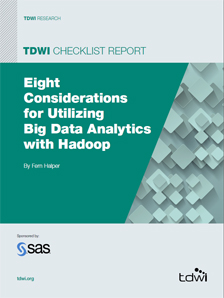
March 10, 2014
As companies seek to gain competitive advantage using advanced
analytics, a sea change is occurring in terms of the data and the
infrastructure that supports it. Several technology factors are coming
together to form the fabric of an evolving analytics ecosystem. These
include:
-
Big data. Companies have been dealing with increasing amounts
of diverse and often high-velocity data for some time. Some of
this big data is new, such as data generated from smartphones
or sensors. Much of it is unstructured, including machinegenerated
data (e.g., satellite images) or human-generated data
(e.g., text data, social media data, or website content). Big data
is putting a strain on current analytical processes.
-
Hadoop. As big data continues to get bigger, companies are
seeking out new technologies to help them cope. One of these
technologies is the Hadoop file system (HDFS) and the ecosystem
of tools surrounding it. Hadoop is an inexpensive solution for
storing and processing big data, especially semi-structured and
unstructured data. It is rapidly becoming an important part of the
big data ecosystem.
-
Advanced analytics. At the same time, there have been
advances in analytics algorithms and analytics processing.
Visualization has helped companies explore data to discover
insights—even with big data. Analytics algorithms such as
machine learning and predictive analytics have matured to
support the distributed processing needed for big data analytics.
Text analytics is helping people derive new meaning from
unstructured data.
Data preparation and staging technologies are evolving to support
big data. In addition, advances such as in-memory analytics and
in-database analytics have accelerated analytics performance,
which has helped organizations analyze data more effectively in
order to compete.
As enterprises look to embrace big data and Hadoop, they have
numerous questions: “How can I deal with data preparation on
Hadoop?” “How does utilizing Hadoop impact visualization and other
kinds of analysis?” “What kind of analytical techniques are available
to analyze Hadoop data?” “How do I use Hadoop with in-memory
processing?”
This Checklist Report focuses on these questions and provides
information to help you explore big data analytics.